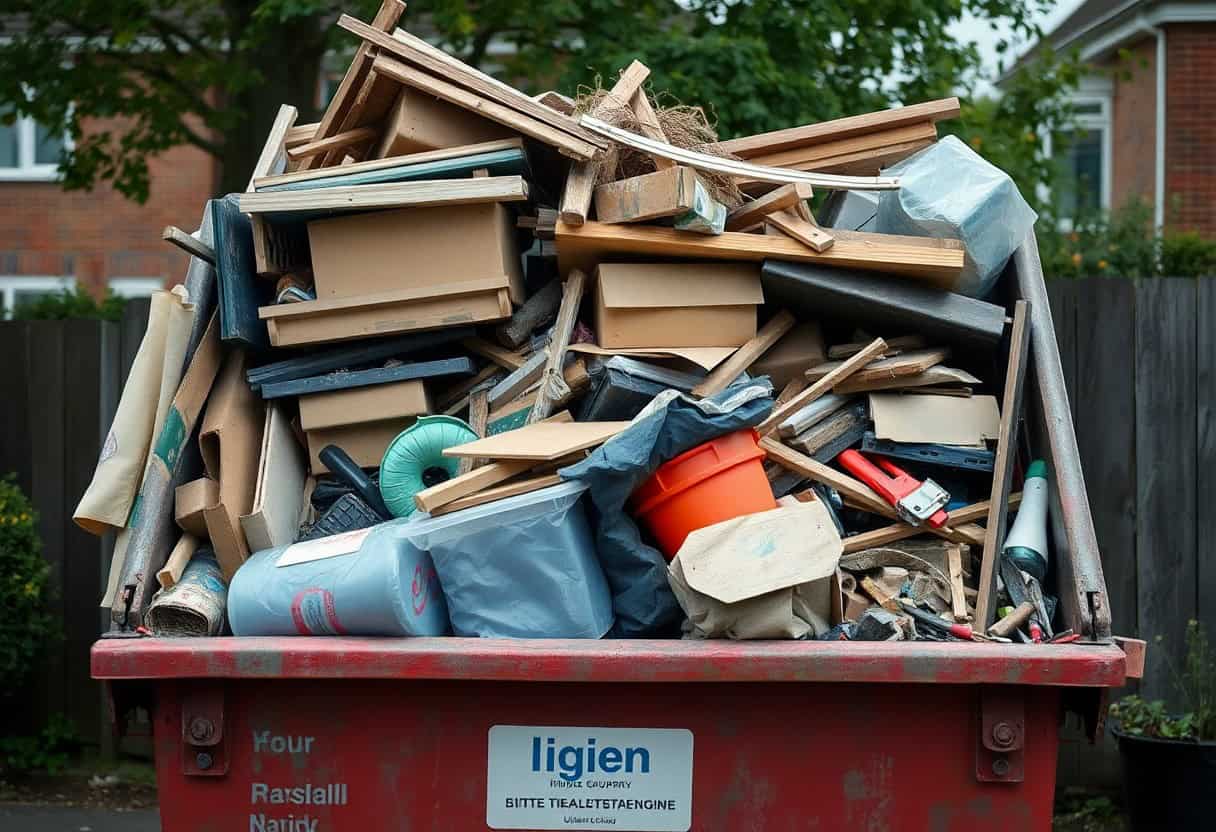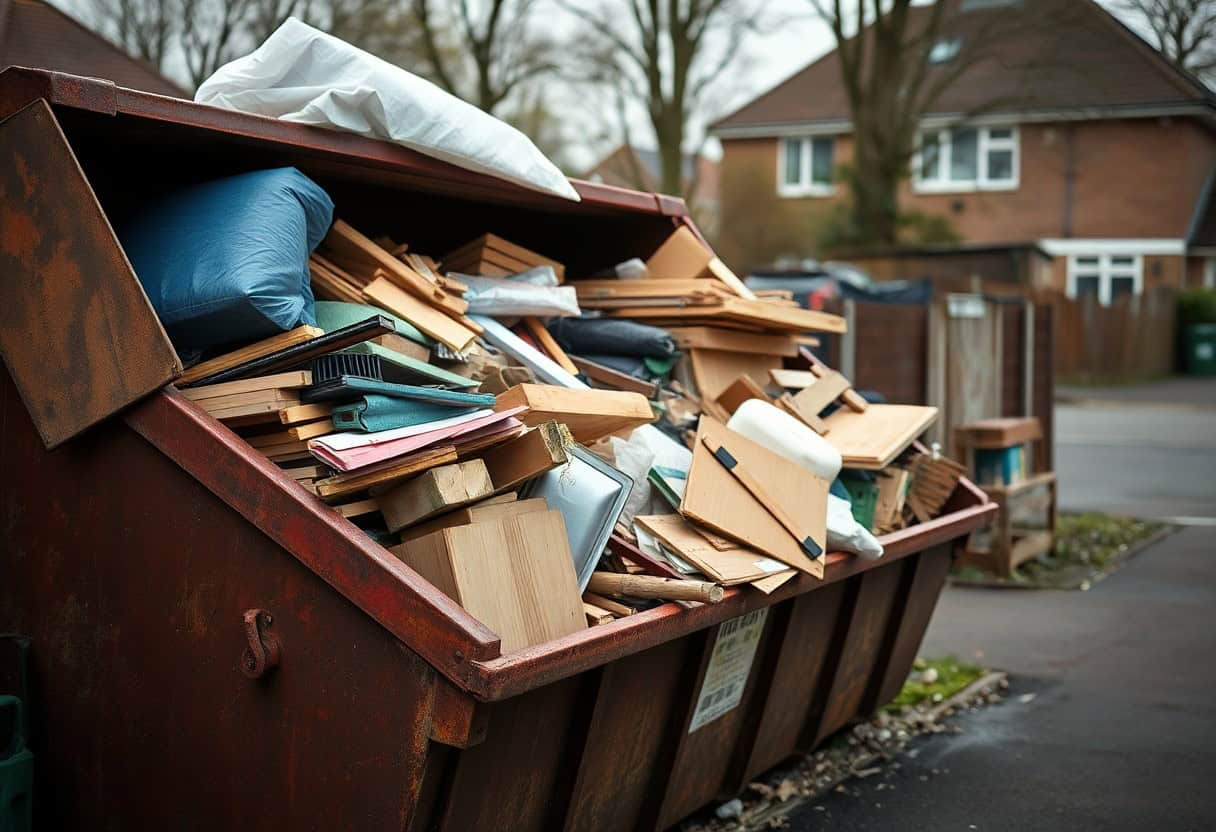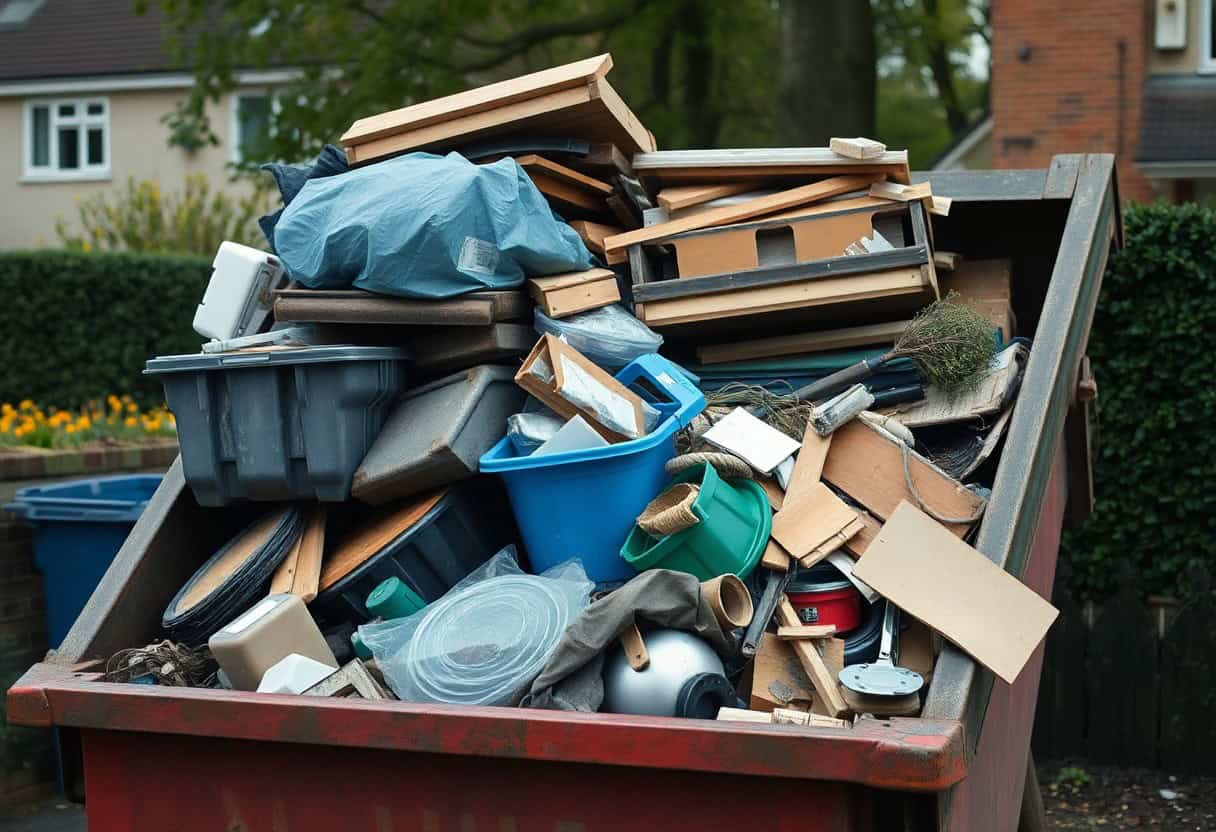Just utilise these tips to ensure you get the most from your skip hire. By efficiently arranging your waste, you can save money and reduce the number of trips needed for disposal. Always prioritise safety when loading items, securing heavier materials at the bottom and keeping sharp objects contained. By understanding the best practices for packing your skip, you’ll not only optimise space but also make the entire process smoother and more effective for your project in Surrey.
Understanding Skip Sizes
A skip’s size can greatly impact the efficiency of your waste disposal. Choosing the right size is necessary for avoiding extra costs and ensuring that all waste fits comfortably within the skip. For guidance on appropriate dimensions, check out What Size Skip Do I Need For a Bathroom?.
Choosing the Right Skip Size
An appropriate skip size can simplify your waste management tasks. Assess the volume of waste you expect to generate, considering both the type and amount. This evaluation ensures that you select a skip that meets your needs, thus streamlining your project and minimising hassle.
Factors Influencing Skip Capacity
On selecting your skip, several factors influence its capacity. The following aspects play a significant role:
- Type of waste – Different materials can affect how much can fit.
- Volume of waste – Estimate how much rubbish you’ll have to dispose of.
- Site accessibility – The location may limit the size of skip you can use.
- Duration of hire – Longer hires may mean more waste accumulation.
Knowing these factors allows for a more precise selection of your skip, avoiding potential inconveniences.
Choosing the right skip size requires careful consideration of the following details:
- Site layout – Limited space may restrict your options.
- Local regulations – Check if permits are needed for larger skips.
- Waste types – Some materials may require specific disposal methods.
Knowing how these elements interact with your specific needs enhances your waste disposal experience and maximises efficiency.

How to Prepare Your Waste for Disposal
Some preparation can significantly enhance your skip’s space efficiency. Before disposing of your waste, ensure items are clean and dry, as this can optimise the volume you can fit in your skip. Additionally, consider breaking down waste into smaller components, making it easier to manage and organise. Disposing of your rubbish efficiently not only helps you save costs but also contributes to a more environmentally-friendly process.
Disassembling Large Items
The act of disassembling large items, such as furniture, allows for better space utilisation within your skip. Take the time to take apart bulky pieces, as dismantled parts can fit more snugly together. This approach will help fill any gaps and maximise the amount you can dispose of.
Sorting Waste Types
Some effective sorting of your waste is important to streamline the disposal process. By categorising your rubbish, you can enhance recycling efforts and adhere to local regulations. Here’s a basic guide to sorting waste:
| Waste Type | Disposal Method |
| Wood | Recycling/skip |
| Metal | Recycling/skip |
| Plastic | Recycling/skip |
| General Waste | Skip only |
Perceiving the type of waste you have will greatly aid in its disposal and enhance recycling potential.
For instance, sorting your waste types not only makes it easier for you but also benefits others. Ensuring all recyclable materials are separated can lead to a more sustainable approach to waste disposal. Here’s a further breakdown of what to sort:
| Waste Type | Tips for Sorting |
| Electronics | Place separately for recycling |
| Glass | Check local recycling guidelines |
| Food Waste | Composting is recommended |
| Garden Waste | Utilise green waste services |
Perceiving the benefits of sorting your waste will encourage a more effective disposal process, fostering an eco-friendly environment.
Tips for Maximising Space Efficiency
Any Surrey resident looking to maximise their skip space should follow these tips for enhanced efficiency:
- You should fill larger items first to create a stable base.
- Break down bulky waste such as furniture for easier packing.
- Ensure you stack items tightly to minimise gaps.
- Use available voids within and between larger items.
For more details on skip dimensions, refer to our Skip Sizes UK – Dimensions, Capacity and Usage Guide. Perceiving these strategies will undeniably enhance your skip’s capacity.
Layering Waste Strategically
There’s a method to layering your waste effectively. Start with the heaviest items at the bottom and gradually add lighter materials on top. This technique helps you maximise the volume of your skip while preventing items from shifting during transportation. Ensure you artfully insert smaller items into the gaps left by larger pieces, creating a more compact load.
Utilizing Vertical Space
Space is often underutilised in skips; however, you can gain significant benefits by stacking your waste. By strategically placing lighter materials atop heavier ones, you optimise vertical space. To maximise this method, always make sure your stack is stable, compact, and evenly distributed. Be aware that using sharp or jagged materials can pose a risk, so avoid overcrowding the top. Always keep safety in mind while managing your load.
With proper utilisation of vertical space, not only will you maximise your skip’s capacity, but you’ll also maintain a safer environment during the load process. Consider incorporating light materials such as garden waste and paper to build height efficiently. Avoid overloading the skip, as this may present a danger during transport. Balancing your load with a focus on stability will help ensure a successful disposal project.
Best Practices for Loading Your Skip
Once again, effective loading is key to maximising your skip’s capacity and ensuring safety. Start by breaking down larger items and placing heavier materials at the bottom to create a stable base. Consider filling any gaps with lightweight materials to use space efficiently. Be mindful of the height of your load, as exceeding the skip’s edge can lead to safety hazards on the road. Following these best practices will not only enhance your skip’s usability but also contribute to a safe disposal process.
Weight Distribution
While you load your skip, it is important to distribute the weight evenly. This avoids overloading one side, which could cause tipping and potential safety risks during transportation. Aim to stack heavier items in the centre and work outwards with lighter materials, ensuring stability throughout the loading process.
Avoiding Overflow
Skip your worries about overflowing waste by packing carefully. Ensure that items are placed within the skip’s limits, keeping the load level with the skip’s rim. This not only maintains safety on the road but also complies with local regulations regarding skip usage.
With proper loading techniques, overflowing waste can be effectively managed. By ensuring your items are properly contained within the skip, you prevent potential fines and legal issues associated with overfilled containers. Additionally, a well-packed skip contributes to safer transportation, helping to avoid materials falling onto roads and causing hazards for other road users. Always aim to keep your load neat and secure, sticking to the recommended height for maximum efficiency and safety.
Common Mistakes to Avoid
Now, when it comes to maximising space in your skip, it’s vital to steer clear of common pitfalls. One of the best resources for Surrey residents is Things you need to know when hiring a skip. Avoiding these errors will help you optimise your disposal efforts and save you time and money.
Overloading the Skip
Commonly, people tend to overload their skips, thinking they can fit just a bit more in. This not only creates safety hazards but may also result in additional charges from your skip hire company. Always ensure you’re aware of the skip’s weight limit and follow guidelines carefully.
Ignoring Local Regulations
Mistakes like ignoring local regulations can severely impact your skip hire experience. Each council may have specific rules on skip placement and waste types, which are designed to maintain safety and cleanliness in your community.
Understanding these regulations is vital because they often specify maximum sizes, weight limits, and allowed materials in skips. Failing to comply could lead to fines or the need to remove your skip unexpectedly. You should check with your local council to ensure you are fully aware of the rules that apply to your area.

Recycling and Waste Reduction Tips
Your efforts in recycling and waste reduction can significantly optimise the use of your skip. Here are some helpful tips:
- Sort your waste before disposal to ensure recyclable materials are separated.
- Use local recycling facilities for items that cannot be placed in your skip.
- Consider donating usable items instead of discarding them.
- Compost organic waste to minimise the volume of rubbish.
Knowing these strategies will enhance your recycling efforts and reduce landfill waste.
Identifying Recyclable Materials
Even seasoned residents might overlook items that can be recycled. Common recyclable materials include paper, cardboard, plastics, and metals. Always check local guidelines, as recycling rules vary by area. By being able to identify these items, you can ensure they are processed correctly, leading to a more sustainable disposal practice.
Responsible Disposal Practices
Practices surrounding waste disposal should prioritise the environment. It’s important to dispose of hazardous waste, such as batteries, chemicals, and electrical devices, at designated facilities to prevent harmful effects on nature. Adopting responsible disposal practices means you not only care for your immediate surroundings but also contribute to wider environmental conservation.
Recyclable items often pose a challenge when it comes to disposal. For instance, electronic waste can contain materials that are dangerous if disposed of improperly. Therefore, it’s imperative to take these items to specialised centres. Additionally, ensure that you handle hazardous materials with care to protect yourself and the environment. Overall, understanding how to correctly dispose of such materials promotes a positive impact on your community.
Final Words
With these considerations, you can significantly enhance the efficiency of your skip usage. By sorting and compacting your waste, stacking items wisely, and avoiding overfilling, you ensure optimal use of the space. This not only saves you money on additional skips but also makes the waste collection process smoother. Following these tips allows you to take full advantage of your skip, contributing to a cleaner environment in Surrey.
FAQ
Q: What are the best ways to load items into a skip efficiently?
A: To optimise the space in your skip, start with larger items at the bottom. Break down bulky furniture or appliances to fit them more snugly. Ensure smaller items fill gaps between larger pieces, and avoid leaving empty spaces. If you have loose materials, consider using bags or boxes to help organise and compact them better.
Q: How can I determine the right skip size for my needs?
A: Assess the volume of waste you have before hiring a skip. Consider measuring your waste, or estimate based on the types of items you plan to dispose of. Skip sizes range from 2-yard mini skips to 12-yard builders’ skips. Consulting with your skip hire provider can also help you choose the most appropriate size to avoid unnecessary costs.
Q: Are there specific items that should not be placed in a skip?
A: Yes, certain items are prohibited in skips due to safety regulations. These typically include hazardous materials such as asbestos, batteries, tyres, and electrical appliances. Always check with your skip hire company for a comprehensive list, as regulations can vary by location.
Q: Can I use my skip for garden waste and construction debris at the same time?
A: While it is possible to mix garden waste with construction debris, it is advisable to separate different types of waste when possible. Some skip hire companies may prefer a clean fill for easier recycling and processing. Check with your provider for their policy on mixed waste to ensure you adhere to their guidelines.
Q: What tips can help reduce the overall amount of waste I need to dispose of?
A: To reduce waste, consider alternatives such as recycling or donating items that are still in good condition. Before putting anything in the skip, take a moment to evaluate whether it can be repurposed or passed on. Additionally, engage in decluttering practices regularly to minimise the amount of waste generated during projects.


